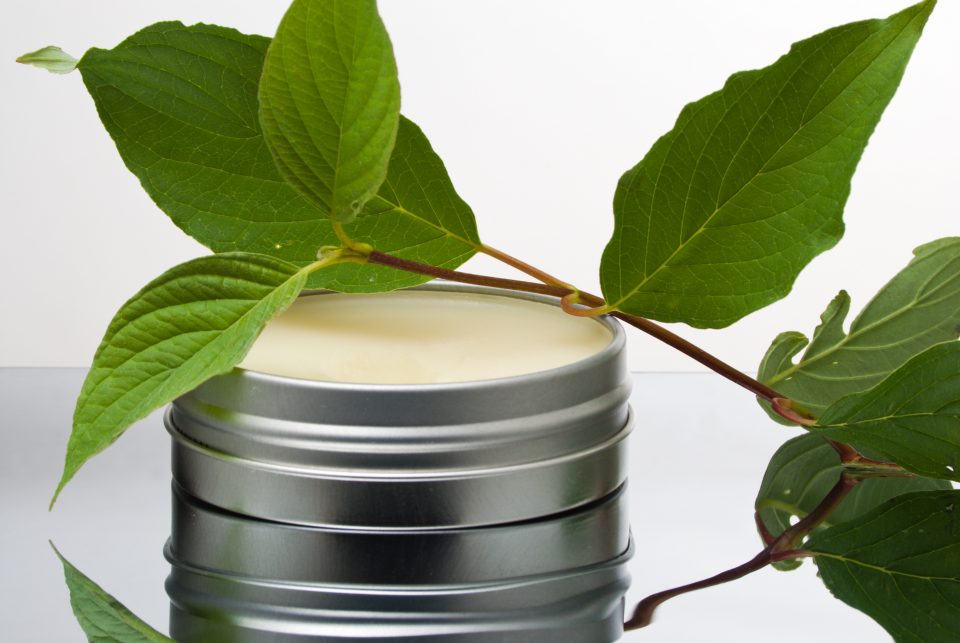Salves are fantastic and so handy to have on hand anytime you get a cut, scrape, bruise, sore muscles, mosquito bite…and more! Salves are semi-solid at room temperature, yet soften when applied to the skin and tend to be less goopy than oils. Salves are created for a variety of external topical uses. Here are just a few of the conditions that can be treated with your homemade herbal salve:
Muscle Pain and Stiffness (Overexertion, Bruises, and Swelling)
- Comfrey Leaf and/or Root Salve— For analgesic/connective tissue healing. Great for sprains, wounds, burns, arthritis, and contusions. Comfery salves relieve pain and swelling, support muscle, cartilage, and bone and can be massaged into the tissue or applied topically.
- Ginger Root Salve— Warming; use for occasional sore muscles. Can be massaged into the tissue or applied topically.
- Arnica Flower Salve— Analgesic (relieves pain) and can help treat physical trauma, bruises, strains, or occasional muscle pain. Use immediately after strenuous exertion or injury to prevent, relieve, and reduce swelling, bruises, and pain. Can be massaged into the sore muscles or applied topically.
- Cayenne Pepper Salve— A very warming salve, good for occasional sore muscles, and alleviates pain and itching. Can be massaged into the tissue or applied topically. Do not use on open sores or cuts… unless you want to be screaming like a zombie!
- Turmeric or fish oil for internal use.
Minor Abrasions, Cuts, Scrapes, and Wounds
- Calendula Flower Salve— Antiseptic, anti-inflammatory, demulcent, vulnerary (heals wounds). Useful for a wide variety of skin irritations and conditions including wounds, insect bites, rashes, scrapes, abrasions, cuts, and much more. Suitable for sensitive skin and babies. For topical use.
- Chamomile Flower Salve— Antiseptic, analgesic. Useful for minor abrasions, cuts, scrapes, and wounds. Applied topically.
- Goldenseal Leaf and/or Root Salve— Antiseptic. Useful for treating minor wounds and skin conditions topically.
- Myrrh Gum Powder Salve— Antiseptic, analgesic. Used for cuts, scrapes, scratches, and abrasions topically.
- Oregon Grape Root Salve— Antimicrobial, astringent, vulnerary herb that contains berberine (berberine kills yeast and bacteria). Fabulous when used topically as a skin disinfectant for minor wounds.
- Thyme Salve— Antiseptic. Used topically for cuts and scrapes.
Burns and Sunburns
- Chickweed Salve— Antipruritic (anti-itch), emollient (softens skin). Soothing; helps topically with skin conditions, minor burns, insect bites, and other skin irritations.
- Lavender Flowers Essential Oil— Analgesic, antiseptic, antimicrobial. Soothing, calming, relieves pain, has healing properties beneficial when used topically for minor wounds and numerous skin conditions.
- John’s Wort Salve— Antibacterial and vulnerary herb that is a profound healer of sunburns. Beneficial for burns, minor wounds, cuts, bruises, muscular pain, insect bites and stings, nerve support, scrapes, and minor burns. Topical use.
Herpes, Eczema, and Psoriasis
- Licorice Salve or poultice has shown to be beneficial for these conditions when used topically.
Insect Bites and Stings
- Echinacea Herb and/or Root Salve— Beneficial for minor sores, wounds, insect bites, and stings.
- Plantain leaf salve— Antipruritic (anti itch), antiseptic. Helps to speed up the recovery process. Relieves and soothes insect bites and stings, poison ivy, itching, minor sores, bruises, blisters, and damaged skin.
How To Make Your Own Salve
To make a salve, first craft your herbal infused oil— How To Make Your Own Herbal Infused Oil.
Then making your homemade salve is as simple as adding one more step!
Ingredients
8 ounces herbal infused oil of your choice
1 ounce beeswax
Glass jars or tin containers
Directions
Place herbal infused oil and beeswax over a double boiler, and gently warm over low heat until the beeswax melts. Remove from heat. Quickly pour into sterilized tins or glass jars and allow to cool completely. Ta-da!
Note: If you prefer a firmer salve, use more beeswax. For a softer salve, use less. Beeswax has emollient, protective, nourishing, soothing, and healing properties.If using coconut oil, depending on your region, you may not need beeswax unless you live in a hot or warm climate.
Storage: Salves are best stored in a cool dry location where they will remain semi-solid and will not melt and solidify repetitively. When properly stored, salves will last for one to three years.





